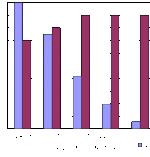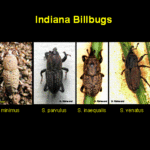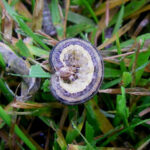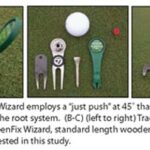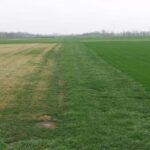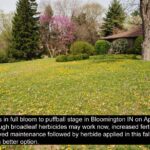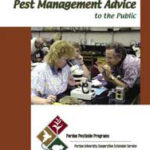Turf Professional
Still time left to sign up for Indiana Green Expo to be held Jan 12-14!
The registration deadline is fast-approaching for the Indiana Green Expo and forms must be postmarked by Dec. 31, 2008. The Indiana Green Expo is the largest turf, ornamental, nursery, and landscape conference in Indiana and is jointly sponsored by the Midwest Regional Turf Foundation, Indiana Nursery and Landscape Association, and now the Indiana Flower Growers […]
How Late is Too Late to Control Dandelions and Other Weeds?
Even though the drought has limited some broadleaf weed applications this month, we are now in the prime season for broadleaf weed control. Actually there is plenty of time left for good control. Nebraska research reported in 2002 showed 2,4-D and/or dicamba were far more effective in controlling dandelions and Canada thistle when applied 1 […]
Billbugs a Pest in 2008? Keep Them in Mind for 2009
This summer saw some extensive billbug damage in many parts of Indiana. Obvious damage to Kentucky bluegrass in the central and northern parts of the state are not uncommon and can usually be attributed to the bluegrass billbug. However, reports of severe damage to Zoysiagrass in the Evansville area really caught my attention. Zoysiagrass is […]
MRTF Golf Day at The Fort in Indianapolis on September 29
Openings are still available for the MRTF Golf Day at The Fort Golf Resort in Indianapolis on September 29. This annual event is held to promote turfgrasss research, raise awareness of the Purdue Turfgrass Science Program, and provide an enjoyable day of golf. With a Centralized location and afternoon shotgun start we hope to draw […]
Armyworms Are Poised For Battle
We have been monitoring reports of very large infestations of armyworm moths flying into Kentucky this spring. Armyworms move north with storms from the southern states each year and depending upon how and where the storms blow will dictate when and how many moths we have to deal with. Fortunately, in Indiana we have not […]
New Options at Midwest Regional Turf Field Day on July 15
Even though the Midwest Regional Turf Field Day is one of the largest in the country, we’re always looking for new and improved ideas. The MRTF Board of Directors and the Purdue Staff have put their heads together and come up with a number of new ideas for this year’s Field Day including: Morning lawn […]
Midwest Regional Turf Field Day on July 15
There’s still time to register for the Midwest Regional Turf Field Day that will be held on Tuesday, July 15 at the W.H. Daniel Turfgrass Research and Diagnostic Center in West Lafayette . The variety and quality of research tours and other opportunities will make this one of the best field days yet. Topics include […]
Mowing height does not affect speed of athletes
We often hear the comment by coaches to change the mowing height of an athletic field when a particularly “fast” or “slow” team is coming to play. In a comprehensive article by Kevin Trotta in a June 16, 2004, “Turf News” article, he clearly showed that mowing height has little effect on player speed. Thought […]
Ball mark Recovery: Does the Repair Tool Matter?
Putting green surface smoothness and uniformity is often disrupted by unrepaired ballmarks. These marks can disrupt surface smoothness and increase the potential for weed (e.g. annual bluegrass) encroachment. The traditional method for repairing ballmarks normally employs a metal pronged tool (≈ 1 in or 3 cm), or tee and using a knit and twist method […]
Color Variation in Residential and Commercial Lawns
During spring green-up, home lawns may reveal many variations in color, growth rate, and leaf width. This variation can be due to some of the following reasons: Species and cultivars: Perennial ryegrass is always the first of the desired cool-season grasses to green-up, followed by tall fescue and eventually Kentucky bluegrass. Within a species, different […]
Reicher on Sabbatical until October 15
You’ll probably notice a slight decrease in frequency and number of Turf Tips this summer as I will be on sabbatical until Oct 15. I will be completing a national survey on Poa trivialis contamination in seed lots. This is a weed that we have been working on for years and it continues to plague golf courses, […]
For professionals: Spring dandelion control
Now that dandelions are flowering or in the puffball stage throughout IN, now is the second best time to control these weeds. Fall applications are still most effective for controlling broadleaf weeds. It does not take much wind to drift and damage off- target ornamentals, gardens, and trees. Choosing low-volatile formulations should reduce the chances […]
For professionals: Where’s Tenacity Herbicide for Lawns?
Tenacity herbicide (mesotrione) is from Syngenta and it will selectively control crabgrass, creeping bentgrass, nimblewill, and a number of broadleaf weeds in cool-season lawns. It is one of the most unique and effective herbicides that we have tested in a long time. Though it was labeled early in 2008 for golf course and sod farm […]
For Professionals: Herbicide Delays after Seeding
Many turf areas required dormant seeding or seeding this spring to help repair damage from last summer and fall. Weed germination is just around the corner and may be problematic on thin turf. Almost all herbicides will affect turfgrass seedlings and application delays are usually needed following seeding. Following is information gleaned from available labels […]
Regenerating Fall Use Athletic Fields
With the fairly wet weather last fall, football and soccer fields have taken a beating. The fields that were aggressively aerified, fertilized, and dormant-seeded last fall should improve dramatically by mid-May. Though improvement won’t be as efficient done now compared to the fall, there is still time to help a field if you missed out […]
Nitrogen and Phosphorus: fertilizing lawns to protect water quality
Healthy turf areas provide many environmental and recreational benefits. A properly fertilized turf has fewer weeds, is more resistant to insect feeding and is less disease prone than malnourished turf. Furthermore, a dense turf slow and decreases water runoff following storm events which helps reduce flooding in urban environments. Concern over water quality is growing […]
For professionals: Seed thin turf now or use weed control?
With last year’s brutal summer and early fall, many areas are in need of reseeding. The question comes up about seeding and weed control: should the weeds be controlled first or should the seeding be done first? This seems like a simple question, but it’s fairly complex depending on the turf and weed species present […]
For Professionals: Choosing a Preemergence Herbicide
There are many, many formulations and combinations of preemergence herbicides available for the professional. Following are some suggestions for purchasing and using preemergence herbicides. Control from every preemergence herbicide can vary from year to year, or location to location. Therefore, you can’t judge the performance of a product or a specific rate of that product […]
For Professionals: Timing of Preemergence Herbicides
If a preemergence herbicide is justified on a turf area, the timing of application is important. In theory, applying too early will expose the herbicide to soil microbes and processes in the soil that may break it down, allowing crabgrass to germinate during the latter part of the summer. Conversely, applying too late may miss […]
Offering Sound Pest Management Advice to the Public (PPP-62)
Purdue Extension Publication
This publication emphasizes the importance of providing sound pesticide advice to customers. Good diagnostic skills are essential. You personally must know and understand the behavior of various pests and have a working knowledge of various control options available; and must ensure that your customers understand your recommendations.
